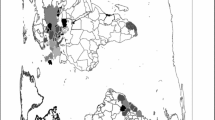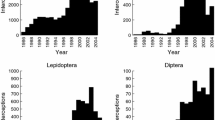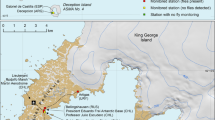Abstract
Invasive species are generally detected in new ecosystems long after their first arrival, making it difficult to elucidate pathways leading to successful invasion. In this study, the dispersal of a classical biological control agent, the mymarid egg parasitoid Gonatocerus ashmeadi, was monitored across ten islands in three major island groups in French Polynesia from the exact moment of its introduction into Tahiti to combat the invasive pest Homalodisca vitripennis. Within 10 months, the parasitoid spread quickly from Tahiti to widely separated islands (up to 1,400 km from Tahiti); presumably through the transportation of plant material containing parasitized H. vitripennis eggs. Gonatocerus ashmeadi thus functioned as a “biomarker”, providing an informal audit of the effectiveness of inter-island quarantine measures designed to curb the accidental spread of noxious organisms. Survey results suggest that invasive organisms, like deliberately released biological control agents, can be unintentionally and rapidly transmitted across vast distances by humans. Furthermore, even remote islands appear to experience relentless pressure from invasive propagules associated with human travel. Implications of survey work documenting the spread and impact of G. ashmeadi are discussed within the context of biological control programs, non-target impacts, and biosecurity initiatives.



Similar content being viewed by others
References
Canto Silva CR, Kolberg R, Romanowski HP, Redaelli LR (2006) Dispersal of the egg parasitoid Gryon gallardoi (Brethes) (Hymenoptera: Scelionidae) in tobacco crops. Br J Biol 66:9–17
Corbett A, Rosenheim JA (1996) Quantifying movement of a minute parasitoid, Anagrus epos (Hymenoptera: Mymaridae), using fluorescent dust marking and recapture. Biol Control 6:35–44
Elton CS (1958) The ecology of invasions by animals and plants. Methuen, London
Fagan W, Lewis MA, Neubert MG, Van den Driessche P (2002) Invasion theory and biological control. Ecol Lett 5:148–157
Gillespie RG, Roderick GK (2002) Arthropods on islands: evolution and conservation. Ann Rev Entomol 47:95–632
Grandgirard J, Hoddle MS, Roderick GK, Petit JN, Percy D, Putoa R, Garnier C, Davies N (2006) Invasion of French Polynesia by the glassy-winged sharpshooter, Homalodisca coagulata (Hemiptera : Cicadellidae): a new threat to the South Pacific. Pac Sci 60:29–438
Grandgirard J, Hoddle MS, Petit JN, Percy D, Roderick GK, Davies N (2007) Pre-introductory risk assessment studies for Gonatocerus ashmeadi (Girault) (Hymenoptera: Mymaridae) for use as a classical biological control agent against Homalodisca coagulata (Say) (Hemiptera: Cicadellidae) in the Society islands (French Polynesia). Biocontrol Sci Technol 17:809–822
Grandgirard J, Hoddle MS, Petit JN, Roderick GK, Davies N (2008) Engineering an invasion: classical biological control of the glassy-winged sharpshooter, Homalodisca vitripennis, by the egg parasitoid Gonatocerus ashmeadi in Tahiti and Moorea, French Polynesia. Biol Invasions 10:135–148
Hengeveld R (1989) Dynamics of biological invasions. Chapman and Hall, London
Hight SD, Carpenter JE, Bloem KA, Bloem S, Pemberton RW, Stiling P (2002) Expanding geographic range of Cactoblastis cactorum (Lepidoptera: Pyralidae) in North America. Fla Entomol 85:527–530
Hoover W (2004) New invader may threaten crops. Published in: the Honolulu Advertiser, May 14, 2004, Honolulu
Irvin NA, Hoddle MS (2007) Evaluation of floral resources for enhancement of fitness of Gonatocerus ashmeadi, an egg parasitoid of the glassy-winged sharpshooter, Homalodisca vitripennis. Biol Control 40:80–88
Laurent V, Maamaatuaiahutapu K, Maiau J, Varney P (2004) Atlas climatologique de la Polynésie française. Météo France—Direction Interrégionale de la Polynésie française
Leibhold AM, Tobin PC (2007) Population ecology of insect invasions and their management. Ann Rev Entomol 53:387–408
Petit JN, Hoddle MS, Grandgirard J, Roderick GK, Davies N (2008a) Short-distance dispersal behavior and establishment of the parasitoid Gonatocerus ashmeadi (Hymenoptera: Mymaridae) in Tahiti: implications for its use as a biological control agent against Homalodisca vitripennis (Hemiptera: Cicadellidae). Biol Control 45:344–352
Petit JN, Hoddle MS, Grandgirard J, Roderick GK, Davies N (2008b) Invasion dynamics of the glassy-winged sharpshooter Homalodisca vitripennis in French Polynesia. Biol Invasions 10:955–967
Pilkington LJ, Hoddle MS (2006) Reproductive and developmental biology of Gonatocerus ashmeadi (Hymenoptera: Mymaridae), an egg parasitoid of Homalodisca coagulata (Hemiptera: Cicadellidae). Biol Control 37:266–275
Sallam MN, Overholt WA, Kairu E (2001) Dispersal of the exotic parasitoid Cotesia flavipes in a new ecosystem. Entomol Exp Appl 98:211–217
Secretariat of the Pacific Community (2002) Incursion of glassy-winged sharpshooter Homalodisca coagulata in French Polynesia. Pest Alert, Plant Protection Service. http://www.spc.int/PPS/PestAlerts/PestAlertNo24.pdf. Accessed Nov 4 2008
Sorensen JT, Gill RJ (1996) A range extension of Homalodisca coagulata (Say) (Hemiptera: Clypeorrhyncha: Cicadellidae) to southern California. Pan Pac Entomol 72:160–161
Takiya DM, McKamey SH, Cavichioi RR (2006) Validity of Homalodisca and of H. vitripennis as the name for glassy-winged sharpshooter (Hemiptera: Cicadellidae: Cicadellinae). Ann Entomol Soc Am 99:648–655
Triapitsyn SV, Phillips PA (2000) First record of Gonatocerus triguttatus (Hymenoptera: Mymaridae) from eggs of Homalodisca coagulata (Homoptera: Cicadellidae) with notes on the distribution of the host. Fla Entomol 83:200–203
Triapitsyn SV, Mizell RF, Bossart JL, Carlton CE (1998) Egg parasitoids of Homalodisca coagulata (Homoptera: Cicadellidae). Fla Entomol 81:241–243
Acknowledgments
We thank the director of the Service du Développement Rural for providing technical and strategic support on this program. We thank Dr. Charles Garnier, Leopold Stein and Rudolph Putoa for their helpful assistance in organizing the program, and the technicians in charge of the insect rearing: Suzanne Liloi, William Ellacott, René Tupana and Joseph Mamatui. Financial support for research on H. vitripennis has been provided by the French Polynesian Government (Convention no 4.0328). Additional support has come from the University of California at Riverside and Berkeley and the University of California, Division of Agriculture and Natural Resources, the California Department of Food and Agriculture, and the Secretariat of the Pacific Community. This paper is contribution #164 of the UC Berkeley Richard B. Gump South Pacific Research Station.
Author information
Authors and Affiliations
Corresponding author
Additional information
Handling Editor: Dirk Babendreier.
Rights and permissions
About this article
Cite this article
Petit, J.N., Hoddle, M.S., Grandgirard, J. et al. Successful spread of a biocontrol agent reveals a biosecurity failure: elucidating long distance invasion pathways for Gonatocerus ashmeadi in French Polynesia. BioControl 54, 485–495 (2009). https://doi.org/10.1007/s10526-008-9204-7
Received:
Accepted:
Published:
Issue Date:
DOI: https://doi.org/10.1007/s10526-008-9204-7




